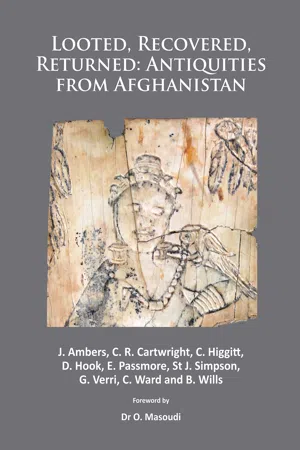
Looted, Recovered, Returned: Antiquities from Afghanistan
A detailed scientific and conservation record of a group of ivory and bone furniture overlays excavated at Begram, stolen from the National Museum of Afghanistan, privately acquired on behalf of Kabul, analysed and conserved at the British Museum and returned to the National Museum in 2012
- 342 pages
- English
- PDF
- Available on iOS & Android
Looted, Recovered, Returned: Antiquities from Afghanistan
A detailed scientific and conservation record of a group of ivory and bone furniture overlays excavated at Begram, stolen from the National Museum of Afghanistan, privately acquired on behalf of Kabul, analysed and conserved at the British Museum and returned to the National Museum in 2012
About this book
The "Begram ivories" are widely considered to be miniature masterpieces of Indian art and are one of the largest archaeological collections of ancient ivories. They were excavated at the site of Begram, in northern Afghanistan, in 1937 and 1939 and belong to a period when Afghanistan, Pakistan and northern India were united under rulers of the Kushan dynasty. Divided soon afterwards between the National Museum of Afghanistan in Kabul and the Musée national des arts asiatiques–Guimet in Paris, the collection in Kabul suffered a disaster during the civil war which ravaged the country during the early 1990s. Some of the pieces were successfully concealed by museum staff but most were stolen, hundreds have since been reported in different collections and very few have yet been recovered. In 2011 a group of twenty bone and ivory plaques was generously acquired for the National Museum of Afghanistan by a private individual. These were scientifically analysed, conserved and exhibited at the British Museum and returned to Kabul in 2012. This book describes their story from excavation to display and return, with individual object biographies and detailed scientific analyses and conservation treatments. It also discusses how these objects have attracted very different interpretations over the decades since their discovery, and how the new analyses shed a completely fresh light on the collection. It is lavishly illustrated in full colour, and includes many previously unpublished views of the objects when they were originally exhibited in Kabul. This book is essential reading for anyone interested in the archaeology of Afghanistan, Indian art, polychromy, museum studies, object biographies or the history of conservation.
Frequently asked questions
- Essential is ideal for learners and professionals who enjoy exploring a wide range of subjects. Access the Essential Library with 800,000+ trusted titles and best-sellers across business, personal growth, and the humanities. Includes unlimited reading time and Standard Read Aloud voice.
- Complete: Perfect for advanced learners and researchers needing full, unrestricted access. Unlock 1.4M+ books across hundreds of subjects, including academic and specialized titles. The Complete Plan also includes advanced features like Premium Read Aloud and Research Assistant.
Please note we cannot support devices running on iOS 13 and Android 7 or earlier. Learn more about using the app.
Information
Table of contents
- Front cover
- Title page
- Copyright page
- Foreword
- Preface by the Sponsor
- Acknowledgements
- Introduction: from Archaeological Discovery to Museum Display
- The Scientific Analyses:
- Analysis of Original and Conservation Materials, Pigments and Metal Pins Associated with a Group of Ivory and Bone Plaques from Begram, Afghanistan
- The Conservation Treatments:
- Conservation of the Ivory and Bone Panels from Begram, Afghanistan
- Catalogue, Scientific Analyses and Conservation Treatment Records
- Bibliography